The article deals with modern learning technology, where the teacher helps students to learn independently, to analyze, organize, assess the acquired knowledge and apply them in their professional activities. The authors provide checklists, compiled on the basis of the pyramid Bloom, criteria and parameters of assessment of practical exercises and project. The project made the subject area chosen development environment and programming language analysis.
The development of information and network technologies dictate new transmission formats and store knowledge. Unique changes in technologies and methodologies of training over the past five years are for the use of information technology in the professional activity of the teacher. Internet Opportunities also led to changes in the choice of emphasis towards learning. So, today, the teacher is not the only source of knowledge and information, and to submit such a volume of information that can provide the Internet is not really in the allotted training hours. Today, the teacher must first teach students to effectively carry out the selection of information, organize it properly depending on the current state of things, and always keep in mind the practical application of it, and not only in the context of the study subjects.
The module «Databases» represented disciplines such as database IP, the development of client-server applications or the design and development of database applications. The main competences of students in the study module «Databases» is the ability to design, implement information systems using programming languages.
Discipline for specialty 5B060200 – «Computer Science», «Client-server application development» is studied in the fourth year and applies to elective subjects. Educational-methodical complex of discipline «Client-server application development» is designed using modern approaches and methods that improve the quality of teaching, used strategies, tools and educational techniques to ensure the effectiveness of the educational process and the educational achievements of students, provide innovative approaches to learning, are transforming into reality the transition from the concept of «transfer ready knowledge» to the concept of «education-formation». Therefore, the discipline is for the synthesis of theoretical knowledge and the acquisition of practical skills in application development. Expected results of the discipline:
Knowledge is
- application development features using Visual Studio environment;
- theoretical foundations of the C # programming language;
- Microsoft .Net Framework platform capabilities for the development and implementation of programs;
Skills are
- to develop, implement and test the client-server application;
- the use of modern tools and programming techniques
- definition of requirements to develop applications [1].
To consolidate the theoretical material for students in practical classes are given individual tasks. As the guidelines are used screencasts. Table 1 shows the test questions, drawn up on the basis of the pyramid Bloom, to consolidate the material on «Concepts C # programming language».
Test questions
T a b l e 1
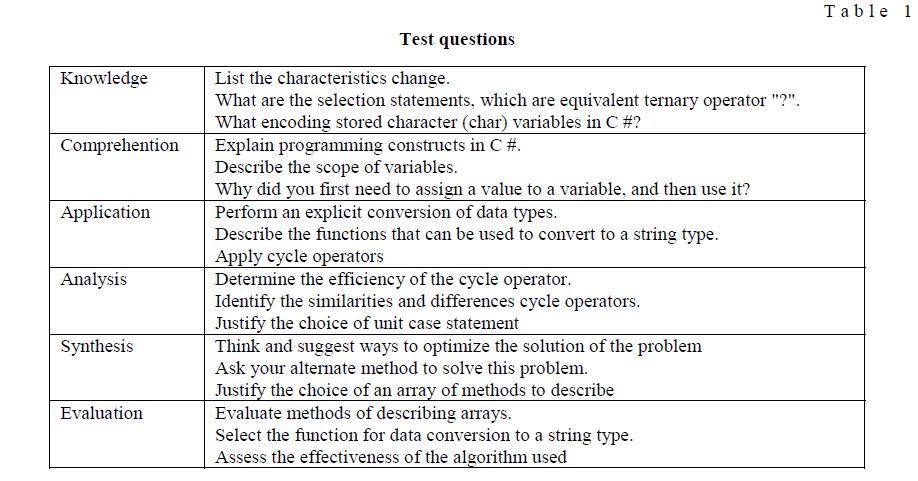
All students are familiar with the criteria of evaluation of practical classes, shown in table 2:
Criteria of evaluation of practical classes
T a b l e 2
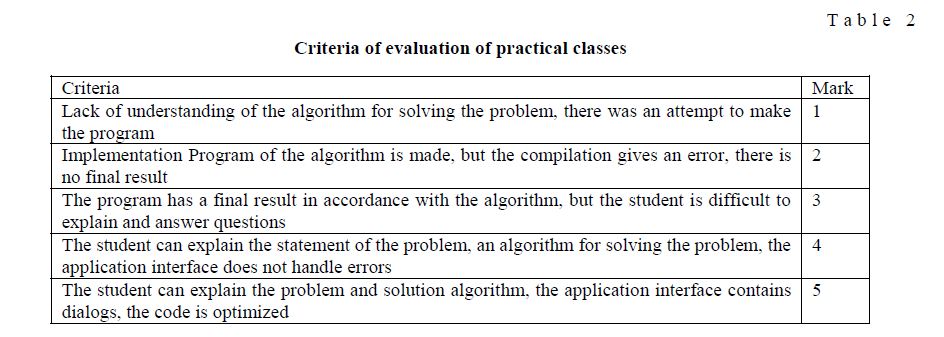
In the process of teaching disciplines of attention of students is drawn to the application development. To consolidate the theoretical knowledge in practical classes, in addition to the forms, students throughout the semester implemented through the development of the project. Information system «Family Budget» is selected for development. The database is designed to store data on the costs and revenues of the workers coming into the family budget. It is intended that this information is subject to change, to participate in the search and reporting [2].
Before proceeding to the development of applications, it is necessary to analyze the domain, which allows you to select entities (objects) are projected database, and to build it in the language model Infological «Tables communication». As a result of analysis, the following objects from the database were identified as Items and Records. Items table is used to store the main types of income and expenses. Details (item_title attribute) can be added, corrected, deleted when the application is running. Introduced attribute «item_id» — a unique numeric identifier assigned mind. The identifier can be hidden from users, since it is only for internal purposes and there is no need to know it. Table «Records» is used to store basic information on money income and expenditure of the family budget.
Development of information system «Family Budget» is intended for automation of business processes. In implementing the project, students must give an overview of the current state of the theory of databases; basic model database management system; gain practical skills for creating a database and use; explore means of visual design environment Visual Studio and C # programming language; «Family Budget» to develop an information system on the basis of theoretical and practical knowledge.
Let us consider the main stages of the development of the information system «Family Budget»:
Development of technical specifications. At this stage, the modeling of the project, a description of the application structure, drafting documentation. As the database has been selected Microsoft Access, designed the two tables «items of income or expense» and «cash income and expense records». Components tables associated with a database file sb.mdb (Fig. 1).
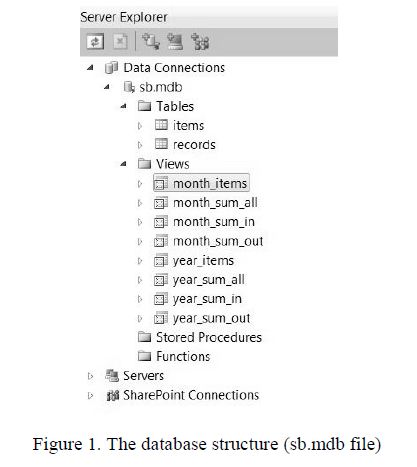
Figure 1. The database structure (sb.mdb file)
Creation of design and navigation. As a development environment was chosen as Visual Studio, in which the detailed drawing and definition of controls, their positioning, the interface design.
Programming. At this stage, the description of the structural and behavioral models of the project translated into a programming language, ie, Writing program code linking control elements placed on the form. As a programming language is set to Visual C #, a new programming language that maintains a Microsoft Access database.
Testing and debugging. The last stage is quite important as the identification of syntax and logic errors of the project determines the further development of the information system.
Appendix «Family budget» is intended for input/ removal of data, correction information in the database, finding relevant data and their filtration capabilities, reporting (Fig. 2). To work correctly, the application should provide training and direct data entry, as well as work in a dialogue with the user modes.
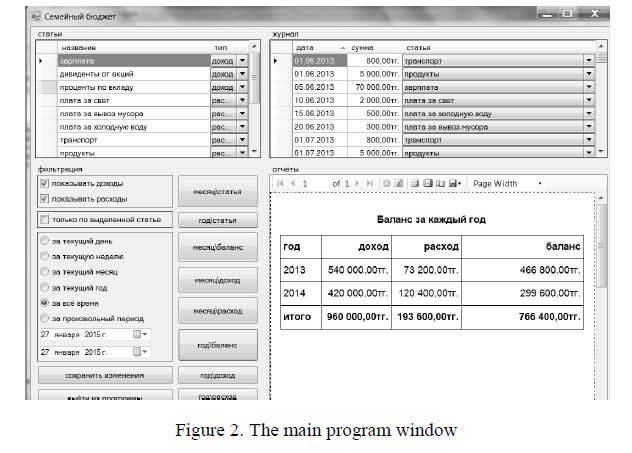
Figure 2. The main program window
The application contains reports for the month and year, respectively, consumption, income, the total budget, request is generated for each report. When developing an application creates a request (Fig. 3), which is associated with the report. The report will be formed on the basis of the data request table (Fig. 4).
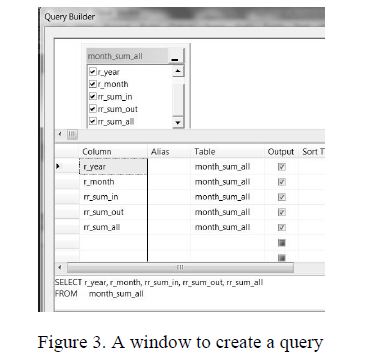
Figure 3. A window to create a query
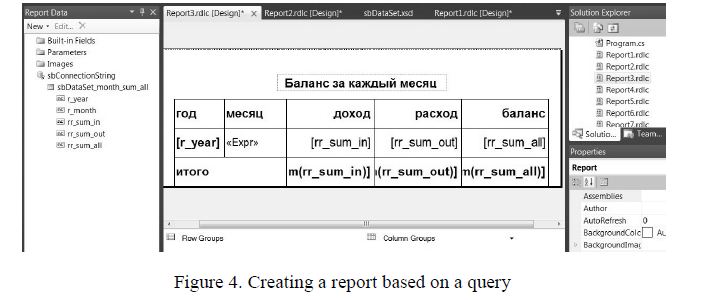
Figure 4. Creating a report based on a query
The database stores information about the kinds of budget, income and expenditure. The database is stored in a separate file and is not attached to the application, so the data can be accessed and any other program. Thus, the possibility of development laid the entire database.
The program reads the information from the database, and performs two functions. Firstly, it provides a database of information in user-friendly form, and secondly, modifies the information search, filtering, printing. To implement the solution to the problem of constructing an information system «Family Budget» you need the following reference such as «Article income», «expenditure», «Reports», «cash balance». «Article income» and «expenditure» implemented as a unifying panel, with a list of articles. Automatically add new articles, and working with tables, you can automatically remove an article. Cash expenses and income are entered in the log group: select the date, the amount is entered, the article selected. Provided for filtering log data (revenues, expenses, through a dedicated article for a certain period of time). Figure 5 shows the result of filtering the data in the log displays revenue for the period.
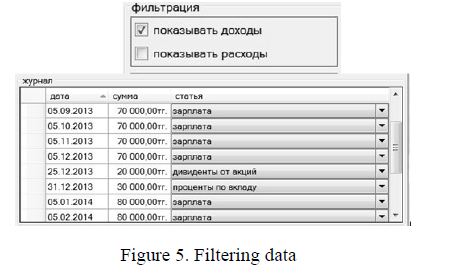
Figure 5. Filtering data
You can search for a specific item of income and expense; the corresponding data are displayed in the log. The app allows you to create eight reports. On the form there are command buttons that are associated with reports accordingly. For reporting data are taken from the query. By clicking on the button in the lower right corner of the main forms of the report is generated automatically. For each report generated form (Figure 6). Among the Visual Studio development such as report article by month, the report articles for years, the balance of the report by month, the report consumption by month, the income statement for the month, the report balance sheet data, the income statement data, report consumption data. To work with the reports formed the standard panel. If the report is more uniform size of the window, the report pages are generated automatically. To navigate through the pages in the panel there are control keys to change the button update report. The report can be printed out on a printer that is connected to a standard printing device. The annex to the report of the panel has a page setup button, to generate output forms. Report results can be saved in xls or pdf format.

Figure 6. A report «Income for each year», generated in Visual Studio
The purpose of the application development can be defined as the implementation of business process management in accordance with the requirements of the customer and the client-server computing model. The system allows you to quickly and easily respond to all your requirements. Information System, created by yourself, can be adapted flexibly to the specifics of the work promptly modernized. The data can be easily edited and added to the database. The program has a simple interface that meets all modern requirements, supplemented with output forms, new modules.
Evaluation criteria and parameters of the project are presented in Table 3.
T a b l e 3
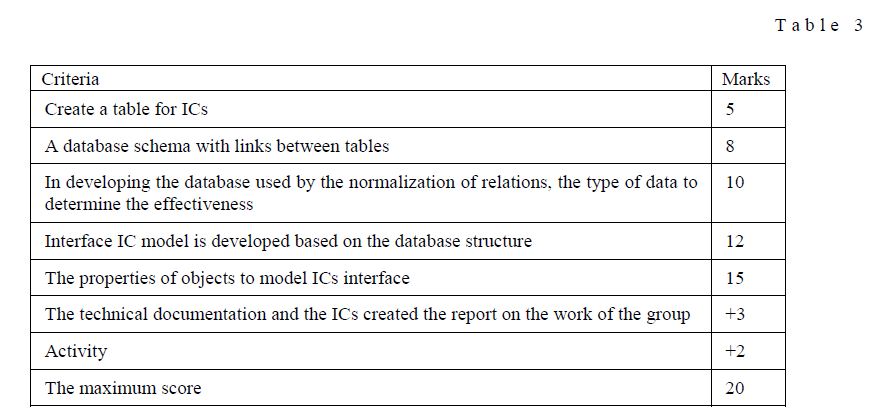
The main result of this work is to create a client-server application using the Visual Studio development environment. All functions are performed by the program were carefully checked and tested during development. The resulting experience of the students can be used for self-realization of the project within the framework of the thesis [3].
Modern information technologies are targeted teacher training on the use of innovative approaches to the educational process, aimed at enhancing the intellectual level of students orienting to think critically and creatively. As a result of the application of these technologies to achieve the set objectives and expected results of the study subjects. Thus, the teacher, speaking consultant, helping students to implement the chosen educational path teaches students self-study, analyze, organize, assess the acquired knowledge and apply them in their professional activity
References
- Alex McKee. Introduction to .NET 4.0 and Visual Studio 2010 for professionals. Publisher Williams,
- Базикова К.М., Допира Р.И., Попова Н.В. Модуль «Базы данных» в подготовке специалистов информационного профиля // Современные актуальные проблемы естественных наук: (14 ноября 2014 г.) Материалы междунар. науч.практ. конф.: Актюбинск,
- Допира Р.И., Попова Н.В., Базикова К.М. Применение современных технологий обучения для дисциплины «Разработка клиент-серверных приложений» // Молодой ученый. — 2016. — № 2 (106). — С. 81–84.